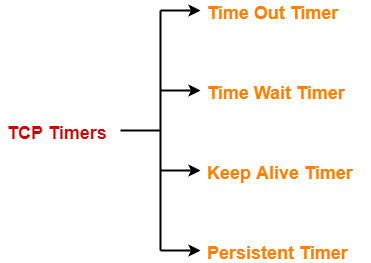TCP Timers-
| Timers used by TCP to avoid excessive delays during communication are called as TCP Timers. |
The 4 important timers used by a TCP implementation are-

- Time Out Timer
- Time Wait Timer
- Keep Alive Timer
- Persistent Timer
Time Out Timer-
| TCP uses a time out timer for retransmission of lost segments. |
- Sender starts a time out timer after transmitting a TCP segment to the receiver.
- If sender receives an acknowledgement before the timer goes off, it stops the timer.
- If sender does not receives any acknowledgement and the timer goes off, then TCP Retransmission occurs.
- Sender retransmits the same segment and resets the timer.
- The value of time out timer is dynamic and changes with the amount of traffic in the network.
- Time out timer is also called as Retransmission Timer.
Time Wait Timer-
| TCP uses a time wait timer during connection termination. |
- Sender starts the time wait timer after sending the ACK for the second FIN segment.
- It allows to resend the final acknowledgement if it gets lost.
- It prevents the just closed port from reopening again quickly to some other application.
- It ensures that all the segments heading towards the just closed port are discarded.
- The value of time wait timer is usually set to twice the lifetime of a TCP segment.
Also Read- TCP Connection Termination
Keep Alive Timer-
| TCP uses a keep alive timer to prevent long idle TCP connections. |
- Each time server hears from the client, it resets the keep alive timer to 2 hours.
- If server does not hear from the client for 2 hours, it sends 10 probe segments to the client.
- These probe segments are sent at a gap of 75 seconds.
- If server receives no response after sending 10 probe segments, it assumes that the client is down.
- Then, server terminates the connection automatically.
Persistent Timer-
- TCP uses a persistent timer to deal with a zero-widow-size deadlock situation.
- It keeps the window size information flowing even if the other end closes its receiver window.
Explanation
Consider the following situation-
To deal with such a situation, TCP uses a persistent timer. |
Also Read- Silly Window Syndrome
- Sender starts the persistent timer on receiving an ACK from the receiver with a zero window size.
- When persistent timer goes off, sender sends a special segment to the receiver.
- This special segment is called as probe segment and contains only 1 byte of new data.
- Response sent by the receiver to the probe segment gives the updated window size.
- If the updated window size is non-zero, it means data can be sent now.
- If the updated window size is still zero, the persistent timer is set again and the cycle repeats.
Next Article- Time Out Timer | Computation Algorithms
Get more notes and other study material of Computer Networks.
Watch video lectures by visiting our YouTube channel LearnVidFun.
Summary

Article Name
TCP Timers | Time Out Timer | Time Wait Timer
DescriptionTCP Timers are used to avoid excessive delays during communication. TCP Timers are- Time Out Timer, Time Wait Timer, Keep Alive Timer, Persistent Timer. Time out timer is used for retransmission. Time Wait Timer is used during connection termination.
Author
Akshay Singhal
Publisher Name

Gate Vidyalay
Publisher Logo
